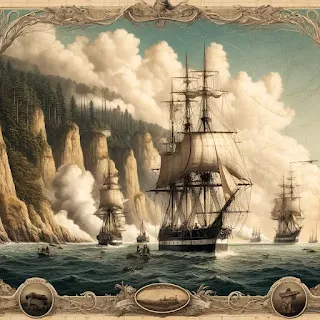Lessons from "The Californian" (1846-1848)
The article discusses the need for patience and restraint in seeking restitution for grievances in California, particularly for those whose property has been taken by individuals connected with the U.S. Service. It emphasizes that resorting to violence will only lead to disaster, as the ultimate resolution of conflicts will be decided through diplomatic channels between the United States and Mexico. The article warns against using the situation in California for personal ambitions or resentment, as it could betray the country and lead to negative consequences.
The author articulates a sensible approach, advising Californians to exercise patience in their grievances against the United States Service, which had begun to assert control over properties in the wake of the war. The assertion that “clamour and haste in seeking the redress of alleged grievances often put the claims of individuals in jeopardy” reflects a critical perspective on the impulsive actions that could undermine legitimate claims. This comment sheds light on a pervasive sentiment of apprehension toward rash reactions in the face of military and governmental encroachment.
The piece highlights the precarious interactions between local populations and federal authorities. The phrase, “those Californians who have remained quiet… may rest assured that in due time restitution will be made,” emphasizes a confidence in legal and bureaucratic processes as opposed to aggressive resistance. This perspective resonates with the broader historical narrative of the era, where legal claims and treaties held more potential for resolution than violent rebellion, which was indeed a threat but ultimately less fruitful.
Furthermore, the author warns against armed conflict, opining that “a recourse to arms can only end in disaster.” This statement underscores the author's belief not only in the futility of violence but also in the havoc it could wreak on both personal and collective futures. The belief in diplomacy over militancy points toward the anticipated processes for settling territorial disputes. The mention of “the fate of California is to be decided not so much by the weapons of belligerents here as by the pens of diplomatic functionaries near home” compellingly frames the situation as one where legal frameworks would ultimately overshadow the chaos of battle, something that was in line with post-war attitudes that favored negotiation over continued conflict.
Moreover, the strong moral condemnation of those who would engage in self-serving ambition—“the man who can do either is callous to every claim of humanity and every sentiment of moral justice”—reflects a deep-seated belief in ethical conduct amidst political turmoil. This illustrates a common wartime discourse where individuals were often judged not just by their actions but by their adherence to larger ideals of justice, humanity, and patriotism.
In conclusion, the article "PRECIPITANCY" serves as a valuable commentary on a distinct moment in Californian history, advocating for a measured, contemplative approach to conflict resolution. It provides insight into the tensions of a society striving to reconcile new governance while safeguarding individual rights amidst larger geopolitical shifts. The author’s call for patience and moral integrity in the face of adversity speaks volumes about the challenges the Californians faced during this transformative period.
The Echoes of Precipitant Grievance: Lessons from "The Californian" (1846-1848)
In a period rife with transformation and upheaval, California transitioned from a mere geographic entity to a pivotal stage for profound socio-political upheaval between 1846 and 1848. The Mexican-American War, the Gold Rush, and the competing aspirations of imperial powers converged in this burgeoning state, where the newspaper "The Californian" emerged as a crucial lens through which to view this complex era. Within its pages, an article titled "Precipitancy" offers invaluable insights into the themes of grievance, conflict, and rights resolution, serving as a cautionary tale against hasty actions in the pursuit of justice.The Context of "Precipitancy"
Delving into "Precipitancy," we find it to be both a reflection of its tumultuous times and a roadmap for navigating adversity. At its core, the article warns against the perils of "clamour and haste in seeking the redress of alleged grievances," highlighting how such urgency can jeopardize individual claims. This message resonates far beyond its immediate historical context, illuminating an ongoing struggle within American identity—one that requires patience and foresight in civic engagement.The years 1846 to 1848 witnessed the eruption of the Mexican-American War, fundamentally altering the territory and demographics of what would become the United States. Controversy surrounding land rights, sovereignty, and the status of Californians—both American settlers and original Mexican inhabitants—set the stage for inevitable conflict. Here, "Precipitancy" serves as both a warning against reckless actions and a call for a collective patience among those wronged by the tides of history.
Public Grievances and the Quest for Justice
As we explore the article’s discourse on individual grievances amidst a backdrop of collective dissatisfaction, its poignant assertion that "the infringement of private rights flows from public exigency as private rapacity" emerges as particularly compelling. The complexities of the Mexican-American War accelerated tensions among American settlers and Californians, often causing individuals to set aside personal interests in pursuit of what they perceived as a collective justice.Interestingly, the article also references "persons connected with the U. States Service," drawing attention to the intricate dynamics of military and civilian interactions during this transformative period. Many of these individuals wielded government power in ways that allowed them to seize land and resources without due process, placing both indigenous peoples and settlers in precarious circumstances. This notion that grievances can be easily inflamed by haste rings especially true; acting impulsively can lead to a forfeiture of essential rights.
The Perils of Violence
One of the article's most striking warnings pertains to the grave consequences of turning to violence: "A recourse to arms can only end in disaster." History offers ample evidence that hastily taken up arms often ignites prolonged conflicts rather than resolutions. The disorganized approach of the War of 1812 serves as a cautionary tale in this regard, illustrating how attempts at justice through aggression frequently neglect the longer-term implications—especially regarding the erosion of rights in the ensuing chaos.Today, similar challenges persist within social movements that grapple with the consequences of violence. Instances where protests devolve into clashes divert public support and derail long-term goals, echoing the article's timeless reminder: well-considered actions are essential to achieving justice, both personally and nationally.
Diplomacy Over Conflict
The author astutely notes, "The contest between the Americans and Californians is not to be conclusively settled here; it will have to be referred to Commissioners appointed by the United States and Mexico." Implicit in this assertion is the fundamental truth that wisdom lies in choosing diplomatic avenues over destructive confrontations. Our world continues to face tensions over territorial and human rights issues that demand resolution through conversation and cooperation.In reflecting upon this historical context, we are reminded that many contemporary issues—ranging from immigration to land rights—benefit not from violence but from constructive discourse and diplomatic efforts. The treaties forged in the aftermath of the Mexican-American War reveal a compelling truth: the pen can reshape nations more effectively than the sword ever could.
Personal Ambition as a Betrayal of Common Good
An insightful observation from "Precipitancy" is its assertion that the pursuit of personal ambitions can betray the common good: "The man who can do either is callous to every claim of humanity and every sentiment of moral justice." This poignant statement underscores not only individual character but also the collective ethos of communities. It serves as a warning against the dangers of allowing ego-driven motives to eclipse the needs of the greater community.When self-interest takes precedence over communal justice, societal fragmentation becomes inevitable. Pursuing personal vendettas often undermines opportunities for constructive collaboration. Whether in political arenas or community organizing, individuals who prioritize collective well-being over personal ambition tend to forge stronger and more resilient societies.
Patience as a Virtue
Perhaps the most powerful lesson conveyed in "Precipitancy" is the profound value of patience. The article advises, "All therefore that the aggrieved have to do is to exercise a little patience, and not forfeit their claims by any rash proceedings." This message resonates not only with the individuals of its time but also with us, echoing a modern sensibility. The urgency for justice often impels us towards rash actions, yet this account reminds us that hasty choices can undermine future claims.In today’s world, the need for patience remains imperative across various spheres, whether within political movements advocating for civil rights or community efforts for environmental justice. Thoughtful, deliberate processes often yield more sustainable results than frantic, short-lived actions. Recent climate change protests exemplify how sustained advocacy and awareness can lead to meaningful change over time.
A Call to Reflection
Engaging with "Precipitancy" invites us into a deep reflection on our contemporary circumstances. The disputes forged during the 1840s resonate strikingly with modern challenges, especially regarding identity, rights, and the necessity for civil discourse. The respect for due process, the patience required for justice, and the capacity to differentiate personal ambition from collective aspirations are critical elements in fostering a just society.Conclusion: The Legacy of "Precipitancy"
The lessons embedded within "Precipitancy" serve as a clarion call to harness the power of historical reflection for our collective betterment. It reminds us that in the midst of turmoil, the pursuit of justice tempered with patience paves the way for future peace and understanding.As we traverse our contemporary landscape, we echo the words of 19th-century Californians, embracing our most human instinct: to seek resolution without losing ourselves in chaos—a quest for dignity, justice, and a brighter tomorrow. In this intricate dance of humanity, the enduring calls for patience, reason, and moral integrity remain ever relevant, guiding us toward a more harmonious existence.
Key Phrases:
1. **Mexican-American War** - A pivotal conflict that shaped modern U.S.-Mexico relations and impacted territorial boundaries. For further reading, see the article on the [Mexican-American War](https://www.history.com/topics/westward-expansion/mexican-american-war) from History.com.2. **Gold Rush** - A significant event that contributed to California's rapid population growth and economic development in the mid-19th century. For more information, please refer to the [California Gold Rush](https://www.history.com/topics/westward-expansion/gold-rush) article by History.com.
3. **Impacts of Violence on Social Movements** - Discusses the negative consequences of violence in protests and movements. For a deeper understanding, see the research paper on [The Impact of Violence on Social Movements](https://www.cambridge.org/core/journals/social-movements-studies/article/impact-of-violence-on-social-movements/9BE26CAD0A65445A0051E4A1A99D18A5) from Cambridge University Press.
4. **Diplomacy vs. Conflict** - Highlights the importance of diplomatic solutions in resolving disputes. For insights into effective diplomacy, consult the article on [The Role of Diplomacy in Conflict Resolution](https://www.usip.org/publications/2020/02/role-diplomacy-conflict-resolution) from the United States Institute of Peace.
5. **Historical Reflection and Justice** - The idea that history can inform modern social justice movements. For more on this topic, see the essay on [Historical Memory and Social Justice](https://www.jstor.org/stable/24404979) from the journal *ProQuest*.
6. **Personal Ambition and Common Good** - Explores the tension between self-interest and collective welfare in society. For further exploration, see the article on [Self-Interest vs. Collective Good](https://www.sciencedirect.com/science/article/pii/S0167577X1730748X) from ScienceDirect.
7. **Patience in Civic Engagement** - Emphasizes the value of patience for long-term social change. For insights on patience in advocacy, read the article on [Patience as a Political Virtue](https://www.apsanet.org/engage/api-gateway/apsa/assets/orp/resource/item/1174/original/patience-as-a-political-virtue.pdf) from APSA.
8. **Social Inequities in Post-War California** - Investigates the socio-economic disparities that emerged in California following the war. For further reading, see the research article on [Social Inequities in California](https://www.jstor.org/stable/460654) from JSTOR.
By exploring these key phrases and provided resources, one can gain a deeper understanding of the historical context, dynamics, and ongoing relevance of the events discussed in "The Californian" and their implications for contemporary society.
**Citation**: The Californian
- PRECIPITANCY., 1847-01-23https://cdnc.ucr.edu/ University of California Riverside Digital Newspaper Archive









